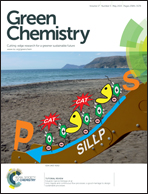Lignocellulose pretreatment technologies affect the level of enzymatic cellulose oxidation by LPMO
Abstract
Sugarcane bagasse, corn stover, and wheat straw are among the most available resources for the production of cellulosic ethanol. For these biomasses we study the influence of pre-treatment methods on the chemical composition, as well as on the subsequent reactions of enzymatic hydrolysis and oxidation of cellulose. The applied pre-treatment methods are organosolv, hydrothermal, and alkaline. Hydrothermally pretreated wheat straw gave the highest cellulose conversion with 80% glucose yield and 0.8% oxidized cellulose products. Recent studies have shown that lignin is able to boost the activity of the cellulose oxidizing enzyme lytic polysaccharide monooxygenase (LPMO). The highest activity of LPMO was observed for the hydrothermally pretreated biomasses, which also contained the highest level of lignin. All hydrolyses were done at high dry matter levels using a commercial enzyme preparation containing hydrolytic and oxidative enzymes.


 Please wait while we load your content...
Please wait while we load your content...